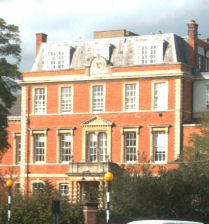History
The hospital was established, by adding new wings to an 18th-century country house, in 1832. [2] The facility was extensively remodeled to a design by David Brandon using a pavilion layout which was heavily influenced by Florence Nightingale through her brother-in-law, Sir Harry Verney of Claydon House. [3] She said that "it will be the most beautiful hospital in England." [3] The new hospital was opened as the Buckinghamshire General Infirmary in 1862. [3]
It is thought that the hospital became "Royal" after the Prince of Wales received treatment there in the late 19th century. [3] A new wing, the foundation stone for which was laid by Lord Rothschild, followed in 1905. [3]
Following the expansion of the Stoke Mandeville Hospital nearby, the Royal Buckinghamshire Hospital joined the National Health Service as a maternity hospital in 1948. [4] It became a private hospital in 1994 and, after acquisition by Affinity Care Homes [5] and an extensive subsequent refurbishment, it reopened as a facility for the treatment of patients with spinal cord, acquired brain injury and other neurological conditions in 2013. [3]
In January 2023, it was announced that the Royal Buckinghamshire Hospital would undergo an extensive refurbishment [6] and be acquired by the Akessa Healthcare Group along with The Foscote Hospital and 107 Harley Street in January 2023. [7] [8]
This page is based on this
Wikipedia article Text is available under the
CC BY-SA 4.0 license; additional terms may apply.
Images, videos and audio are available under their respective licenses.

